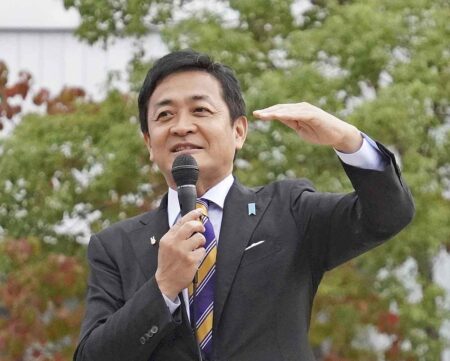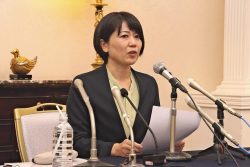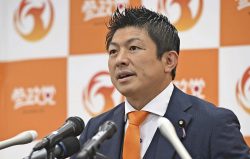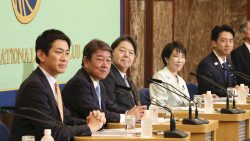Japan’s JIP Struggles to Attract Voters, Even in Base of Osaka; DPFP Seen to be Slowly Gaining Momentum, Likely to Gain Seats

Democratic Party for the People leader Yuichiro Tamaki speaks in Hiroshima on Thursday.
2:00 JST, October 26, 2024
The Japan Innovation Party has been struggling to win support since the start of campaigning for the upcoming House of Representatives election.
There is no sign of the momentum it saw in the 2021 lower house race in which the party greatly increased the number of seats it held. Close races are expected, even in its base of Osaka Prefecture. With little support seen outside of the Kansai region, it is difficult for the JIP to become the national political party it wishes to be.
Of the 163 constituencies where it has fielded candidates, the JIP is leading in only seven — six in Osaka Prefecture and one in Kyoto Prefecture. In Osaka Prefecture, where the party has fielded candidates in all 19 constituencies, 13 are expected to be tight races. The party’s influence is weak outside the Kansai region and has managed a close contest in only three constituencies — Aichi No. 10, Hiroshima No. 4 and Fukuoka No. 11.
The lack of momentum can be attributed to the public’s disappointment in the JIP, which is seen as “being taken in” by the ruling Liberal Democratic Party after it agreed with the LDP on the revised Political Funds Control Law in the latest ordinary Diet session. A series of scandals, including the alleged workplace bullying and harassment by the JIP-supported former Hyogo Gov. Motohiko Saito, might have also fueled public frustration.
“I want to do my utmost to appeal to every voter through our policies in this tough election campaign until the very end,” Osaka Gov. Hirofumi Yoshimura, who is a coleader of the JIP, told reporters on Thursday in Osaka.
In contrast to the JIP, the Democratic Party for the People has turned the tide of seemingly lost battles in five constituencies since the start of campaigning. The DPFP will likely increase its proportional representation seats to more than 10.
“A hike in take-home pay” is the slogan the DPFP has been using in trying to appeal to working-age voters. The party’s policies, including the active use of nuclear power plants, are similar to the JIP’s. The DPFP appears to be taking on the role the JIP held in the previous election. It is believed to be attracting voters who are dissatisfied with the government but are staying away from the left-wing nature of the Constitutional Democratic Party of Japan.
“Please help us fulfill our promises and not let them become pipe dreams,” DPFP leader Yuichiro Tamaki said Thursday at a street speech in Hiroshima. “Let’s get stagnant Japan moving again.”
"Politics" POPULAR ARTICLE
-

Japan to Support Central Asian Logistics Route That Bypasses Russia, Plan to Be Part of Upcoming Summit in Tokyo
-

Japan to Tighten Screening of Foreigners’ Residential Status by Providing Information of Nonpayment of Taxes
-

Takaichi Cabinet Approval Holds at 72% as Voters Back Aggressive Fiscal Stimulus, Child Benefits
-

Chinese, Russian Bombers Flew Unusual Path by Heading Toward Tokyo; Move Likely Meant to Intimidate Japan
-

Takaichi Meets Many World Leaders at G20 Debut in Johannesburg; Speaks with Heads of Countries Including Italy, U.K., Germany, India
JN ACCESS RANKING
-

Keidanren Chairman Yoshinobu Tsutsui Visits Kashiwazaki-Kariwa Nuclear Power Plant; Inspects New Emergency Safety System
-

Imports of Rare Earths from China Facing Delays, May Be Caused by Deterioration of Japan-China Relations
-

University of Tokyo Professor Discusses Japanese Economic Security in Interview Ahead of Forum
-

Japan Pulls out of Vietnam Nuclear Project, Complicating Hanoi’s Power Plans
-

Govt Aims to Expand NISA Program Lineup, Abolish Age Restriction
























